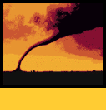Tornado Safety In Homes or Other Small Buildings
The best places are:
- In a storm shelter specifically designed for that use — within the basement or outside the home entirely. Some companies manufacture pre-fab shelters that you drop into a hole in the ground, and that blends in with home landscaping (some more, some less).
- In a basement, away from the west and south walls. Hiding under a heavy work-table or under the stairs will protect the family from crumbling walls, chimneys, and large airborne debris falling into the cellar. A family in the April 8th, 1998 tornado in the Birmingham, Alabama area survived because a hutch toppled and was held up by the dining room table they were under. That hutch helped deflect the debris that would have struck them. Old blankets, quilts and an unused mattress will protect against flying debris, but they should be stored in the shelter area. Precious time can be lost by trying to find these items at the last minute.
- In a small, windowless, first floor, interior room like a closet or bathroom. The bathtub and commode are anchored directly into the ground, and sometimes are the only thing left in place after the tornado. Getting into the bathtub with a couch cushion over you gives you protection on all sides, as well as an extra anchor to the foundation. Plumbing pipes may or may not help hold the walls together, but all the extra framing that it takes to put a bathroom together may make a big difference. If there is no downstairs bathroom and the closets are all packed with “stuff,” a hall may be the best shelter. Put as many walls as you can between yourself and the tornado. In a pinch, put a metal trash can over as much of you as will fit inside. It will keep some flying debris from injuring you. Even that may make the difference between life and death.
Wherever it is, the shelter should be well known by each member of the family. If you and your family will conduct annual emergency drills(fire, tornado, etc), everyone will remember what to do and where to go when a tornado is approaching -- automatically and without panic. Choose a friend or family member in another part of town or elsewhere to be a “contact person” that will be called by everyone should the family members become separated.
FEMA (the Federal Emergency Management Agency suggests you build a “disaster supplies kit” that you keep in your shelter area.
Recommended Supplies List PDF)
A basic emergency supply kit could include the following recommended items:
- Water, one gallon of water per person per day for at least three days, for drinking and sanitation
- Food, at least a three-day supply of non-perishable food
- Battery or hand crank radio and a NOAA Weather Radio with tone alert and extra batteries for both
- Flashlight and extra batteries
- First aid kit
- Whistle to signal for help
- Dust mask to help filter contaminated air and plastic sheeting and duct tape to shelter-in-place
- Moist towelettes, garbage bags and plastic ties for personal sanitation
- Wrench or pliers to turn off utilities
- Manual can opener for food
- Local maps
- Cell phone with chargers, inverter or solar charger
This is the most basic kit, and does not include many items that would be needed if you were without power or the ability to get around for a few days. Other items that might be prescription medicines, infant formula, diapers, and pet food. The importance of clean drinking water cannot be emphasized enough.
Canned food items should used and then replaced at least once a year to make sure the kit items are both safe and edible.
A wide variety of dried and freeze-dried foods are available for backpackers, and other outdoor enthusiasts and have a very long shelf life. They are widely available on both the internet and in stores that specialize in camping supplies. Also available on the internet and army surplus stores are MREs (meals ready to eat) that also have a longer shelf life than canned goods.
Items in the kit can be enclosed in zipped plastic bags and then stored in plastic totes or trash cans to keep them dry and safe from vermin.
Now that you have read our “Safety Page”, try the “Tornado Safety Crossword Puzzle” in our Storm Cellar.

